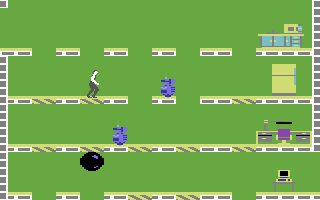Odyssey is a side-scrolling platform adventure game developed by Unconscious Minds and published by Audiogenic Software in 1993. It was released exclusively for the Amiga. The game was designed by Reece Millidge and Chris Mullender, who created an ambitious exploration-based adventure that predated the widespread adoption of what would later be termed the "Metroidvania" genre, making it a unique entry in the Amiga's software library.
Odyssey stands as a visual masterpiece that showcases the Amiga's graphical capabilities at their finest. The pixel art demonstrates exceptional attention to detail, with lush alien environments that feature multiple layers of parallax scrolling and atmospheric lighting effects that create genuine depth and mood. The protagonist moves with fluid animation that rivals contemporary console releases, while the various alien creatures and mechanical enemies display impressive sprite work that brings the mysterious world to life. The color palette takes full advantage of the Amiga's superior color reproduction, creating alien landscapes that feel genuinely otherworldly yet cohesive in their design aesthetic.
The presentation extends beyond graphics to encompass excellent sound design that utilizes the Amiga's audio capabilities effectively. The ambient soundtrack creates an appropriately mysterious atmosphere, with haunting melodies that complement the exploration-focused gameplay. Sound effects provide satisfying feedback for player actions, from the protagonist's footsteps echoing through cavernous spaces to the distinctive audio cues of various alien technologies and environmental hazards.
However, Odyssey's greatest strength becomes its most significant weakness through punishing difficulty design that frequently crosses the line from challenging to unfair. The game features numerous instant-death traps that provide little warning or visual indication of their presence, forcing players to memorize hazard locations through repeated failures rather than skillful observation. Precision platforming sections demand pixel-perfect timing and positioning, often requiring players to restart lengthy sequences after minor mistakes. The save system exacerbates these issues by spacing checkpoints too far apart, meaning single errors can cost significant progress and force repetition of already-conquered challenges.
The exploration mechanics reveal clear inspiration from Metroid and Castlevania, featuring interconnected areas that open up as players acquire new abilities and equipment. Power-ups include enhanced jumping capabilities, improved weapons, and environmental suits that allow access to previously unreachable areas. The level design encourages backtracking and thorough exploration, with hidden passages and secret areas that reward careful investigation. However, the harsh difficulty often overshadows these positive elements, as players may become frustrated before experiencing the satisfying progression system.
Odyssey deserves recognition as one of the Amiga's few genuine Metroidvania experiences, a genre that remained relatively rare on home computers compared to consoles. While the Amiga featured excellent platform games like Flashback and Another World, these titles focused on cinematic storytelling rather than exploration and character progression. Traditional platformers such as Zool and Superfrog offered polished jumping mechanics but lacked the interconnected world design and ability-gated progression that defines the Metroidvania genre.
As an Amiga exclusive, Odyssey represents the kind of unique gaming experience that made the platform special during its heyday. The game demonstrates that Amiga developers could create experiences that rivaled console Metroidvania titles like Super Metroid or early Castlevania entries in terms of visual presentation and atmospheric world-building. The alien setting provides a unique aesthetic that distinguishes it from the more familiar sci-fi corridors of Metroid or gothic castles of Castlevania, creating an identity that feels distinctly European in its approach to the genre.
The game's weapon system offers satisfying progression, with various alien technologies providing different combat options and strategic approaches to enemy encounters. Environmental puzzles require creative thinking and careful observation, though they sometimes suffer from obtuse solutions that compound the game's accessibility issues. The interconnected world design reveals impressive ambition, with areas that feel genuinely alien yet logically connected through consistent internal geography.
Compared to other Amiga platform adventures, Odyssey stands apart through its emphasis on non-linear exploration and character progression. While games like Prince of Persia and Rick Dangerous focused on precise platforming and puzzle-solving within linear structures, Odyssey encouraged players to revisit areas with new abilities, creating a more dynamic relationship with the game world that few other Amiga titles attempted.
Odyssey represents both the potential and limitations of exclusive Amiga development during the platform's later years. While Millidge and Mullender created a technically impressive game that pushed the hardware to its limits and offered a unique gaming experience unavailable elsewhere, the punishing difficulty design prevents it from reaching the broader audience that might have appreciated its innovations. The game stands as a fascinating example of European developers experimenting with genres that would later become standardized, offering a glimpse of what the Amiga gaming scene achieved when developers had complete creative freedom on their preferred platform.







